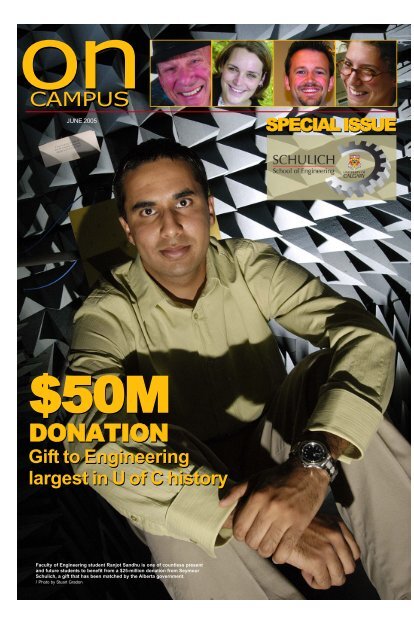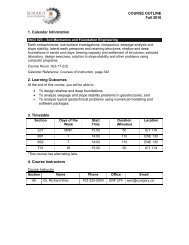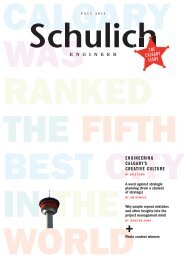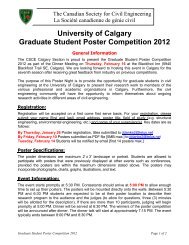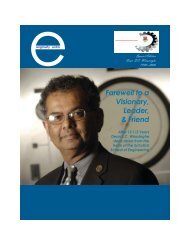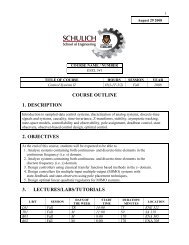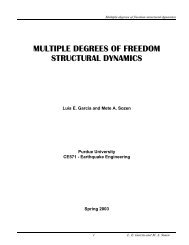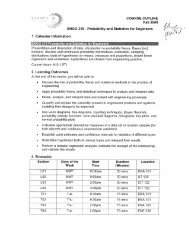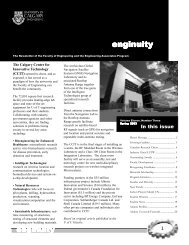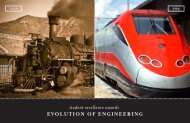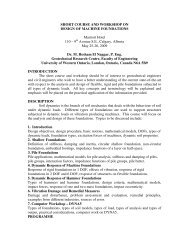On Campus Engineering Edition - The Schulich School of ...
On Campus Engineering Edition - The Schulich School of ...
On Campus Engineering Edition - The Schulich School of ...
Create successful ePaper yourself
Turn your PDF publications into a flip-book with our unique Google optimized e-Paper software.
onCAMPUSCAMPUSJUNE 2005SPECIAL ISSUE$50MDONATIONGift to <strong>Engineering</strong>largest in U <strong>of</strong> C historyFaculty <strong>of</strong> <strong>Engineering</strong> student Ranjot Sandhu is one <strong>of</strong> countless presentand future students to benefit from a $25-million donation from Seymour<strong>Schulich</strong>, a gift that has been matched by the Alberta government./ Photo by Stuart Gradon
MILESTONES1957After six years <strong>of</strong> pursuit,University <strong>of</strong> Alberta grantsfirst-year <strong>Engineering</strong> programto Calgary branch, to start atthe SAIT campus in Septemberwith 59 students and twoengineering staff members.1960University <strong>of</strong> Alberta, Calgary(UAC) moves to new(present) campus and<strong>Engineering</strong> programsare expanded to includesecond-year courses.1965April 1 – Faculty statusachieved. Dr. Adam M.Neville appointed as firstDean <strong>of</strong> the Faculty <strong>of</strong><strong>Engineering</strong> in Calgary.THEN & NOWBy Kirk Thurbide<strong>The</strong> University <strong>of</strong> Calgary’s Faculty <strong>of</strong><strong>Engineering</strong> opened the door to itsfirst students in the fall <strong>of</strong> 1965.Its beginnings were humble: 59students, two faculty members.Since then, the faculty has grown to becomeone <strong>of</strong> Canada’s premier engineering schools,boasting a full-time undergraduate enrolment <strong>of</strong>over 2,400, a full-time graduate enrolment <strong>of</strong>800, 182 faculty members and 109 staff members.“[<strong>The</strong> Faculty] is a roaring success now,” sayspr<strong>of</strong>essor emeritus Robert Loov, who taught atthe University <strong>of</strong> Calgary from 1963 to 1999.“Initially pr<strong>of</strong>essors had to be a bit <strong>of</strong> a jack <strong>of</strong>all trades. We had to lecture on all sorts <strong>of</strong> topicsoutside <strong>of</strong> our main areas <strong>of</strong> expertise. Duringmy early years I taught everything from draftingto computing to surveying, in addition to mycivil engineering courses. Now everyone is anexpert in their respective areas.”Loov left his mark on the U <strong>of</strong> C as one <strong>of</strong> theoriginators <strong>of</strong> the Arch entryway to campus. Healso <strong>of</strong>fered input into the construction <strong>of</strong> what isnow the engineering complex.<strong>The</strong> faculty is marking its 40th anniversarythis year, one year ahead <strong>of</strong> the University <strong>of</strong>Calgary as a whole.<strong>The</strong> faculty has its roots as a division <strong>of</strong> engineeringunder the University <strong>of</strong> Alberta, Calgary(UAC), reports Peter Glockner in his book, APlace <strong>of</strong> Ingenuity, which chronicles the historyFaculty celebrates40th anniversaryfocus, have catapulted the faculty into its statusas one <strong>of</strong> Canada’s premier engineering schools.“<strong>The</strong> biggest difference I have noticed is thatour faculty has grown and now has the confidenceto be ‘First Choice’ in Canada”, says ChanWirasinghe, PEng, Dean <strong>of</strong> <strong>Engineering</strong>. “It isnot simply intrinsic growth; we have addednumerous key programs, research centres andsuperb people.”Wirasinghe predicts further growth for the faculty.“I believe we have to grow by another 50 percentto be among the very best in the world.Currently we excel in many areas but we need tobe world leaders and to have a critical mass in atleast 10 more [areas] to take ourselves to the toplevel. I believe that the naming <strong>of</strong> the <strong>Schulich</strong><strong>School</strong> <strong>of</strong> <strong>Engineering</strong> will be key in providingus with resources to achieve this.”<strong>Engineering</strong> Building 1969Celebrate<strong>Engineering</strong>’shistory with us<strong>The</strong> entire engineering complex is comprised <strong>of</strong> several buildings, including<strong>Engineering</strong> Block F, above, and blocks A, B, C, D and E. <strong>Engineering</strong> pr<strong>of</strong>essorsand students also work in CCIT, ICT and the Petro-Canada Building./ Photo by Ken BendiktsenonCAMPUS<strong>of</strong> the Faculty <strong>of</strong> <strong>Engineering</strong>. <strong>The</strong> initial satellitecampus was established in 1957 on the SAITcampus (then the Institute <strong>of</strong> Technology andArt). <strong>The</strong> opening <strong>of</strong> the UAC campus (current U<strong>of</strong> C campus site) was in the fall <strong>of</strong> 1960, and theUAC engineering campus moved into theScience and <strong>Engineering</strong> Building (now ScienceA). Construction <strong>of</strong> the current <strong>Engineering</strong>Complex began in 1963, and as the faculty’sprogram <strong>of</strong>ferings grew to include third- andfourth-year courses, the Faculty <strong>of</strong> <strong>Engineering</strong>gained greater independence.<strong>The</strong> first meeting <strong>of</strong> the <strong>Engineering</strong> Councilwas held on September 28, 1964 at which time aproposal was made requesting the establishment<strong>of</strong> a Faculty <strong>of</strong> <strong>Engineering</strong> in Calgary. Facultystatus was granted effective April 1, 1965 withDean Adam Neville appointed as the first dean <strong>of</strong>engineering in Calgary. With plans for autonomywell under way, the UAC name <strong>of</strong>ficiallychanged in 1966 to the University <strong>of</strong> Calgary.Hal Thompson was a member <strong>of</strong> the faculty’sfirst graduating class, which was responsible forthe establishment <strong>of</strong> the <strong>Engineering</strong> Students’Society. “I look at the impressive facilities, variousdisciplines and record <strong>of</strong> contribution andexcellent reputation <strong>of</strong> today’s U <strong>of</strong> C engineeringfaculty and chuckle to remember its humblebeginnings.”Over the past two decades, the faculty hasembraced rapid changes in technology and nurturedcloser associations with industry. Those initiatives,combined with its advanced research<strong>The</strong> Faculty <strong>of</strong> <strong>Engineering</strong> will host several40th anniversary celebrations thisyear. <strong>The</strong>y include:<strong>Engineering</strong> AssociatesProgram BreakfastAs part <strong>of</strong> the annual breakfast series,the EAP will celebrate the 40thAnniversary on Friday, September 23.<strong>The</strong> event will include the inaugural<strong>Engineering</strong> Alumni Excellence Awardpresentation and a distinguished alumniguest speaker.<strong>Engineering</strong> Alumni Excellence Award<strong>The</strong> <strong>Engineering</strong> Alumni ExcellenceAward (EAEA) was established in 2005to commemorate the 40th Anniversary<strong>of</strong> the Faculty <strong>of</strong> <strong>Engineering</strong> and to recognizethe outstanding success <strong>of</strong> alumnifrom the Faculty <strong>of</strong> <strong>Engineering</strong>. <strong>The</strong>Faculty <strong>of</strong> <strong>Engineering</strong> has more than10,000 alumni in 84 countries aroundthe globe. <strong>The</strong> EAEA recognizes andhonours personal achievement andextraordinary service to the Faculty <strong>of</strong><strong>Engineering</strong> and to the community. <strong>The</strong>award will be handed out September 23.June 2005 Page 2
MILESTONES1966April 1 – U <strong>of</strong> C established as anautonomous institution. Departments <strong>of</strong>Chemical, Civil, Electrical and Mechanical<strong>Engineering</strong> established.1967M.A. Sheikh isthe first PhDgraduate fromthe faculty at thefall convocation.1968May 27 - Centennial sculpture presentationserves as the un<strong>of</strong>ficial opening <strong>of</strong> the<strong>Engineering</strong> Complex with A Block nearingcompletion.DONATIONBy Grady SemmensDonation benefitsstudents, researchersMarie-Mai Parent, a chemical engineering student, biopharmaceuticalspecialization, works in a biological sciences lab./ Photo by Stuart GradononCAMPUS<strong>The</strong> Faculty <strong>of</strong> <strong>Engineering</strong>’s 10-year planto become the leading engineering schooland the school <strong>of</strong> “First Choice” inCanada received a major boost with a$25-million donation from a Canadianphilanthropist that will be matched by the Government<strong>of</strong> Alberta.<strong>The</strong> gift is the largest donation in the University <strong>of</strong>Calgary’s history and will provide a dramatic increase insupport for engineering students beginning this fall. <strong>The</strong>donation also heralds the naming <strong>of</strong> the faculty in honour<strong>of</strong> the donor, Seymour <strong>Schulich</strong>. <strong>The</strong> Calgary school willbe the first engineering school in Canada to be named, arare and unique honour. <strong>The</strong> <strong>Schulich</strong> <strong>School</strong> <strong>of</strong><strong>Engineering</strong> will use the donations, which total $50 million,to create an endowment and 102 new scholarships, increasefunding for student field trips and engineering societies,found three new engineering research chairs and enhancelearning. <strong>The</strong>se investments are aimed at attracting the topengineering students from Calgary and around the world.“<strong>The</strong> 10-year strategic plan for the Faculty <strong>of</strong> <strong>Engineering</strong>talks about improving the student experience. <strong>The</strong> <strong>Schulich</strong>donation allows us to do just that,” U <strong>of</strong> C President Dr.Harvey Weingarten said. “People aren’t willing to give thisamount <strong>of</strong> money to a university unless they think it can besuccessful and has appropriate leadership. This is a reflection <strong>of</strong>confidence in us and where we’re going.”<strong>Schulich</strong>, a director and the largest private shareholder <strong>of</strong>Newmont Mining Corp., the largest gold mining company in theworld, said he saw the opportunity as a chance to continue hislegacy <strong>of</strong> supporting excellence in post-secondary education inCanada. He is also the namesake <strong>of</strong> York University’s businessschool, the University <strong>of</strong> Western <strong>On</strong>tario’s medical school and hasmade numerous gifts and created scholarships at universities acrossthe country, including the $6,000 Julius <strong>Schulich</strong> Award forEntrepreneurship, which is named after his father and has beenawarded to MBA students at U <strong>of</strong> C annually since 1985.“Engineers are society’s builders and innovators. <strong>The</strong>y play a vitalrole in creating the infrastructure and services that support the standard<strong>of</strong> living we enjoy in modern society,” <strong>Schulich</strong> said. “We needmore engineers in Canada, and this pr<strong>of</strong>ession was an easy choice forour third benefaction.”Dean <strong>of</strong> <strong>Engineering</strong> Chan Wirasinghe, PEng., said the increasedfunds will help the school achieve its goal <strong>of</strong> becoming the First Choicein Canada for the most talented engineering students in Canada by2013. “We want to be the first choice for students in Canada who wantto study engineering, and we want our graduates to be the first choice <strong>of</strong>employers who want to hire engineers. This benefaction is going to makea huge difference because it will help us retain and attract the very beststudents and pr<strong>of</strong>essors.”Mike Kallos, PEng., a pr<strong>of</strong>essor <strong>of</strong> biomedical engineering, said adopting<strong>Schulich</strong>’s name will enhance the faculty’s reputation across Canadaand the world. “I think it’s great,” Kallos said. “We have a really high quality<strong>of</strong> teaching and research here, butour reputation isn’t quite up to whatwe <strong>of</strong>fer. I think having a name likehis on our faculty will go a long wayto help that.”Second-year U <strong>of</strong> C studentMandy Dunlop, who will studychemical engineering this fall, saidthe donation will have a huge impact on students. “I think more top studentswill choose to come to school here because <strong>of</strong> these scholarships, and moremoney for clubs and field trips will keep them here.”<strong>The</strong> donation came together quickly after the university began seeking individualdonors interested in partnering with the faculty last fall. <strong>Schulich</strong>, who is from<strong>On</strong>tario, was interested, but wanted to be sure he would not be taking the opportunityaway from a local benefactor. He challenged the U <strong>of</strong> C to exhaust the city fora donor, and over the course <strong>of</strong> four months, and in consultation with a group <strong>of</strong>community advisers, it was determined that his gift would not displace another’s.<strong>Schulich</strong> visited campus on March 10 to meet U <strong>of</strong> C leaders and to talk to fourengineering students about how the money could best be spent. <strong>The</strong> university laterasked the province, which had recently announced the $3-billion Access to theFuture Fund, to match <strong>Schulich</strong>’s $25-million donation, resulting in the fourthlargestdonation to a university in Canadian history.Donation:In BriefSupporting top-quality engineeringstudents, and not just those withthe best marks, is the focus <strong>of</strong> the$50-million donation made to the<strong>Schulich</strong> <strong>School</strong> <strong>of</strong> <strong>Engineering</strong> byphilanthropist Seymour <strong>Schulich</strong> andthe Alberta government.<strong>The</strong> bulk <strong>of</strong> the donation will bespent on the creation <strong>of</strong> 102 newundergraduate engineering scholarshipsaimed at attracting studentsfrom Calgary and beyond. Recipientswill be top academic achievers, aswell as those who are involved intheir communities and have shownentrepreneurial talent. <strong>The</strong> creation<strong>of</strong> such scholarships is a key platform<strong>of</strong> the faculty’s 10-year plan“First Choice.”<strong>The</strong> new scholarships include:• 15 scholarships <strong>of</strong> $20,000 peryear for students from outside <strong>of</strong>Calgary based on academic grades;renewable for up to three years.• 15 scholarships <strong>of</strong> $20,000 peryear for non-Calgary students basedon community service and entrepreneurialachievements; renewable forup to three years.• 21 scholarships <strong>of</strong> $10,000 peryear for Calgary students based onacademic grades; renewable for upto three years.• 21 scholarships <strong>of</strong> $10,000 peryear for Calgary students based oncommunity service and entrepreneurialachievements; renewable forup to three years.• 30 scholarships covering tuitionfees for one year for engineeringstudents chosen by the dean <strong>of</strong>engineering; non-renewable.<strong>The</strong> endowment will also provide$200,000 per year for expensesrelated to student field trips and$200,000 for supporting the activities<strong>of</strong> student clubs, teams andassociations directly related to engineering.<strong>The</strong> faculty considers suchactivities to be crucial for educationand for leadership and has supportedthem throughout its 40-year history.<strong>On</strong> top <strong>of</strong> student support, thegift will fund the creation <strong>of</strong> threenew chairs in engineering researchby September 2006. <strong>On</strong>e chair willbe in biomedical engineering; theother two are still to be determined.A dean’s discretionary fund <strong>of</strong> upto $500,000 per year will also becreated to cover expenses such asfaculty travel, fundraising, recruitmentand student job placement.June 2005 Page 3
MILESTONES1969First BSc graduatingclass participates atspring convocation.1970B.J. Mathiesenbecomes the firstfemale graduate <strong>of</strong>the faculty.1975Demand for the programleads to the establishment<strong>of</strong> enrolment cap <strong>of</strong> 350 forfirst-year class.DONORBy Tom MaloneyTORONTOWhat drives a manto give so much?Inside the Newmont Capital boardroom at theintersection <strong>of</strong> Yonge and Eglinton in midtownToronto, a LeRoy Neimen original hangson one wall and a John DeMott painting decoratesanother. A formidable bronze <strong>of</strong> a rideron horseback by Frederic Remington sits prominentlyon a table. <strong>The</strong> tranquil view from the corner windowsoverlooks the lush green neighbourhoods <strong>of</strong> thecity north toward the uptown <strong>of</strong>fice towers.For all those visual lures, the one piece that grabsand holds a visitor’s attention is a simple rectangularglass case, easily held in two arms. Lettering etchedinto the outside glass celebrates what Seymour<strong>Schulich</strong> classifies as one <strong>of</strong> his big “lottery wins,” thetakeover <strong>of</strong> his companies, Franco-Nevada MiningCorporation and Normandy Mining in 2002 byNewmont Mining. Price tag: $14 billion. Suspendedin the same case are a six-shooter and a blade, andwritten on a black backdrop in silver letters are thesewords: “You don’t bring a knife to a gunfight.”<strong>Schulich</strong>, 65, approaches philanthropy with a similarphilosophy. A decade ago, he set out to endow 400annual scholarships personally. Come September, hewill have done all that, and much more. When thefourth and last <strong>of</strong> his major donations is announcedformally in September, to his alma mater McGillUniversity, he will have given $100 million or approximately20 percent <strong>of</strong> his net wealth to Canadian universities.“This is one <strong>of</strong> the greateststatements <strong>of</strong> philanthropy inour country’s history,” saysclose friend LawrenceBloomberg, formerly chief executive<strong>of</strong>ficer and chairman <strong>of</strong>the board <strong>of</strong> National Bank andFirst Marathon, presentlychairman <strong>of</strong> Mt. Sinai Hospitalboard <strong>of</strong> directors in Toronto. “He cares deeply aboutCanada, and he cares very much about educating ournext group <strong>of</strong> Canadians.”His $25-million sponsorship <strong>of</strong> the University <strong>of</strong>Calgary’s engineering school is the third <strong>of</strong> fourmajor donations. <strong>Schulich</strong>, a native <strong>of</strong> Montreal, haspreviously financed the <strong>School</strong> <strong>of</strong> Business at YorkUniversity, and the Faculty <strong>of</strong> Medicine at theUniversity <strong>of</strong> Western <strong>On</strong>tario. <strong>The</strong> McGill endowmentwill be directed toward the arts.“He’s like a virtual university, all on his own,”jokes Alvin Libin, the matchmaker among <strong>Schulich</strong>,U <strong>of</strong> C President Harvey Weingarten and<strong>Engineering</strong> Dean Chan Wirasinghe, PEng.TonCAMPUSJune 2005 Page 4
MILESTONES1979Surveying <strong>Engineering</strong>program approved.1980Construction <strong>of</strong> F Block(Civil <strong>Engineering</strong> Building)begins. Courses in ProjectManagement initiatedby Civil <strong>Engineering</strong>.1990Division <strong>of</strong> Manufacturing<strong>Engineering</strong> establishedwithin Mechanical<strong>Engineering</strong> Department.<strong>The</strong> pledge to U <strong>of</strong> C is the first in Canada foran engineering faculty and, as at York andWestern, the school will bear his name.“Giving money away intelligently is truly moredifficult than earning it,” <strong>Schulich</strong> says, fromacross the boardroom table. “It’s difficult to do itright. I’m trying to set up something to last intoperpetuity, and it’s difficult to see what the futurewill look like. <strong>The</strong> ones I’ve done so far, I’vealready gone back and done more.”At York, the original $15-million donation, thefirst <strong>of</strong> its kind in Canada, grew when he spurreda $100-million fundraising campaign for a newbuilding with a $7-million grant, then chaired the“Giving money awayintelligently is truly moredifficult than earning it.It’s difficult to do it right.”Seymour <strong>Schulich</strong>, philanthropistand U <strong>of</strong> C donorfundraising committee and sponsored teachingawards besides. In common, the key is that eachbenefaction is characterized by direct funding tostudents. At Western, for instance, more than 100students receive $15,000 to $20,000 annually. AtU <strong>of</strong> C, 102 scholarships ranging from $6,000 to$20,000 will be awarded annually, half based ongrades, the other half hinged on community service,club participation and entrepreneurship.“You succeed in life by doing lots <strong>of</strong> things,”<strong>Schulich</strong> says, and the pursuit <strong>of</strong> various experiencescan be mitigated by the student’s “burden<strong>of</strong> debt” during school, then long into their pr<strong>of</strong>essionallives.Still, what drives a man to give so much touniversities and their students? This is a question,<strong>Schulich</strong> says with a sly smile, that his familyalso asks.In 1963, having received a Bachelor <strong>of</strong> Sciencefrom McGill, <strong>Schulich</strong> won a $1,600 scholarshipfrom a financial firm, a sum <strong>of</strong> money he praisesas “the most important” <strong>of</strong> his life. By rolling thedice on a pair <strong>of</strong> stocks, and with that actionforetelling a willingness to gamble shrewdly inhis business life, he paid <strong>of</strong>f the MBA tuition andtravelled for three months in Europe. His entiresuccess in business, he says, is grounded in the“eight years <strong>of</strong> experience” gained during twoyears <strong>of</strong> schooling at McGill.A voracious reader – just try leaving his <strong>of</strong>ficewithout one <strong>of</strong> several books stacked on a credenza– <strong>Schulich</strong> also admits to being a manintent on leaving a legacy. He is troubled that thememory <strong>of</strong> a friend and “the smartest businessmanI’ve ever known,” Stephen Roman, wascompromised when the company he had builtfrom scratch, Consolidated Denison Mines,struggled financially following his death.Compared with Americans, Canadians give 50onCAMPUSSeymour <strong>Schulich</strong> has long loved and appreciated the West. With his $25-million donation,he says he’s giving something back to Alberta. / Photos by Clint Adam Smythcents on the dollar to charities and other causes.By giving to universities, <strong>Schulich</strong> means toserve as a catalyst. That some <strong>of</strong> the country’swealthiest individuals spend more time hidingmoney <strong>of</strong>fshore than dedicating the funds todomestic matters “bothers me,” he says. “It doesn’tmatter to me what people do, just do something.”Finally, and perhaps most critically in the decisionto endow U <strong>of</strong> C, there is his love andappreciation <strong>of</strong> the West. As a kid growing up ina lower-income family in a working class area <strong>of</strong>Montreal, he read tales <strong>of</strong> the Old West to bidetime in a home without television. “<strong>The</strong> West hasbeen a fixation for as long as I’ve knownSeymour,” says Bloomberg. “When I was firstintroduced to him, he was wearing cowboyboots, a hat and a belt buckle. To this day whenyou go out with him, he’s wearing Western-styleclothing.”Romance aside, as an investor, starting withspectacular success in Bonanza Oil and Gas, heput money into 15 Alberta-based companies, <strong>of</strong>which one dozen became acquisition targets. Heestimates that up to one-third <strong>of</strong> his wealth cameout <strong>of</strong> Alberta, and he wants to “give some back.”After McGill, <strong>Schulich</strong> obtained a CharteredFinancial Analyst degree from the University <strong>of</strong>Virginia, started in business with Shell Canada,moved to Eastern Securities as an investmentcounsellor, and then to Beutel, Goodman & Co.as partner and vice-president. He moved with thecompany to Toronto in 1977, served as presidentfor three years to 1980, and remains as vicechairmanemeritus.Meantime, <strong>Schulich</strong> moonlighted with a partner,Pierre Lassonde, to launch Franco-NevadaMining in 1982 as a bit <strong>of</strong> a lark – Franco,because Lassonde is French Canadian, andNevada because <strong>Schulich</strong> played some seriouspoker in his spare time. So begins a tale abouthis “law <strong>of</strong> unintended consequences.” Havingachieved significant pr<strong>of</strong>its by investing in gasand oil royalties, <strong>Schulich</strong>, so long as he’d bespending time in Nevada, decided to bring thesame tactic to the gold mining industry. Aftermore than 40 attempted ventures, the company,which was going broke, went public in 1983.Three years later, they broke through by paying$2 million (US) for a four-percent slice <strong>of</strong> revenuesin a mine operated by Western StatesMinerals, plus rights to adjacent land. Productiondoubled in less than one year, to generate $23million annually in royalties.<strong>Schulich</strong> embraces the Bobby Fischer axiomas a secret to business. “How do you beat thegreat chessmaster?” he asks rhetorically. “Playanything but chess.” In the 1990s, as gold fellbelow $285 and chilled investors, the contrarianscontinued investing in companies for a percentage<strong>of</strong> revenues – not pr<strong>of</strong>its – plus liens onland next to the mine “as kickers.” Says<strong>Schulich</strong>: “<strong>The</strong> objective is not to win the deal,but to do a deal where both sides will end uphappy.”Timing is everything. In April 2001, Franco-Nevada bought 20 percent <strong>of</strong> Australia-basedNormandy Mining just before it became thetarget in a takeover battle. Lassonde and<strong>Schulich</strong> convinced Newmont Mining to outbida South African company for Normandy, and toabsorb Franco-Nevada in one fell swoop. Byconsequence, this time well-intended, Franco-Nevada, with all <strong>of</strong> 21 employees, wound upwith a 32 percent stake in Newmont worth $3billion, and Newmont’s shares would appreciateanother 50 percent in the year to come.Says Bloomberg: “I’ve been in investmentbanking for nearly 40 years, and Seymour isprobably the best investor I’ve ever seen. He’sgot great intuition.”As <strong>of</strong> late last year, his holdings in Newmontand two Calgary-based concerns, Great CanadianOil Sands and Blackrock Ventures, were togetherworth a reported $500 million. Says Bloomberg:“He’s made a lot <strong>of</strong> money and you’d neverknow it, except for his philanthropy.”<strong>Schulich</strong> has lived in the same house inToronto for more than 25 years and driven aLincoln Continental for 10 years. “I can call allover the world with the phone in that car,” says<strong>Schulich</strong>. “<strong>The</strong>y don’t make those phones anymore,so I won’t trade in the car.”In spite <strong>of</strong> his success, <strong>Schulich</strong> was a virtuallyunknown entity in <strong>On</strong>tario until he began makingendowments.He’s been married to Tanna for 35 years, andthey travel to the same Swiss resort and stay inthe same room every year. <strong>The</strong>y love hiking inColorado. <strong>The</strong>y have two daughters, Deborahand Judith, and two grandchildren, Jade andSolomon.“He’s smart, strategic, philosophical,humourous and he loves being a grandfather,”says Bloomberg. “If he’s your friend, he’s yourfriend for life. In business school, I got a veryhigh temperature and couldn’t study anymore.He came over to my house to coach me; riskedgetting sick himself to help me with the finalexams.”<strong>Schulich</strong> received the Order <strong>of</strong> Canada in2001. As a member <strong>of</strong> the Canadian Council <strong>of</strong>Chief Executives, he is invited to speak to thegroup but doesn’t dare presume he has much inthe way <strong>of</strong> stimulating speech to share. And so,he has humbly declined. He might consider atalk on philanthropy.“He’s extremely generous, not only with hismoney, but his time,” says Dezso Horvath, Dean<strong>of</strong> the <strong>Schulich</strong> <strong>School</strong> <strong>of</strong> Business at York.In fact, Weingarten and Wirasinghe mightwant to limber up the legs. Horvath gets anoccasional call from <strong>Schulich</strong> to spend up t<strong>of</strong>our hours on a Sunday on a long walk. <strong>The</strong>y’lltalk about everything from globalization to strategyat the school. “He never interferes, not evenwhen he disagrees with a direction,” saysHorvath, but adds he will fax hand-written congratulationsto the school for achievements incompetitions.As for the poker tournaments, they’re a thing<strong>of</strong> the past. “I got tired <strong>of</strong> sitting around with alot <strong>of</strong> dysfunctional people, breathing in a lot <strong>of</strong>smoke,” <strong>Schulich</strong> says, with a laugh.Instead, he’s found a worthier way to spend histime, and money.June 2005 Page 5
STUDENTSerinSPATEErin Spate, 20, chose engineering forits wide range <strong>of</strong> career possibilities.What she didn’t count on was discoveringa whole different world.In her first year <strong>of</strong> studies, Spatesigned on with the local chapter <strong>of</strong> EngineersWithout Borders (EWB), a group <strong>of</strong> students thatgives its time, skills and resources to help developingcommunities abroad access technology.“EWB is an awesome outlet that really letsyou see the changes that a student can make evenwithout experience,” Spate says. “EWB was aplace that I could go to learn about internationalissues that weren’t taught in high school, withouthaving to worry about homework, assignments orgrades.”As the group’s HIV/AIDS commissioner,Spate promoted education on the crisis caused bythe disease in Africa. She was also in charge <strong>of</strong>organizing local events. Juggling EWB activitieswith her studies was sometimes a challenge.“Midterms and finals can be difficult becausethere are lots <strong>of</strong> distractions you could be doing,such as projects or updates for EWB,” saysSpate, who is going into her third year.But Spate is pushing ahead, and plans eventuallyto research renewable energy.“Renewable energy is something on whichwe need to focus more time and resources if wewant to maintain our current way <strong>of</strong> life.”In the meantime, Spate is learning from hersummer engineering job with MechWave, whereshe’s learning the complexities <strong>of</strong> building banksand grocery stores. She hasn’t ruled out workingthrough EWB one day.“EWB is like a cement truck going at 100miles an hour. It is going to make a difference nomatter who is driving or who it hits!” she says.“It has definitely introduced me to some optionsthat I would have otherwise never heard about.”Erin Spate linked up with Engineers Without Borders in her first year. / Photo by Stuart GradonraymondTSOIRaymond Tsoi had his sights set onspace research from a young age —and now he’s living his dream.Tsoi, 23, a third-year master’sstudent in geomatics engineering, isresearching navigation techniques for so-calledswarms <strong>of</strong> mini-satellites. <strong>The</strong>se swarms, used byNASA and other space agencies, fly in formationand use Global Positioning System technology toavoid colliding with one another and for configurationcontrol.Tsoi says the formation technique — a relativelynew way <strong>of</strong> deploying satellites — makessense.“By combining the information from severalautonomous satellites rather than flying all theinstruments on one costly spacecraft, [it] reducesthe mission risk, production cost and operationcost.”Formation flying also gives a different perspectivefrom each satellite, which combined,provide images <strong>of</strong> higher resolution.<strong>The</strong> satellites gather information such as thevariability <strong>of</strong> Earth’s gravity, which depends onthe mass distribution <strong>of</strong> Earth. NASA and theGerman Aerospace Center are currently conductingsimilar research.Tsoi says more than 30 space missions areplanned, which will use the formation techniqueto explore Earth and deep space.Tsoi’s own research includes validating theuse <strong>of</strong> GPS for formation flying.It’s a field that’s long held his fascination.“I have always been attracted by frontier technologiesand innovations,” he says. “Having theopportunity to do research on the leading spacetechnologies can fulfill my desire.”Raymond Tsoi is living his dream <strong>of</strong> conducting space research. / Photo by Stuart GradononCAMPUSJune 2005 Page 6
danielVISSERGraduate student Daniel Visser wants to use his engineering degree to make a difference in people’s lives. / Photo by Stuart GradonFirst-year graduate student DanielVisser designs custom-built braces forpeople suffering from scoliosis.In the past, custom-built braces,which exert pressure on the spine topush it back into alignment, have been made byhand-modifying a plaster torso replica. <strong>The</strong>process hasn’t been standardized, and the result,in some cases, has been poor-fitting braces.To ensure newer braces fit properly, Visser, abiomedical engineering student, uses computermodelling.“We have a method that reproduces thepatient’s torso digitally, and then the digital torsoreplica is altered in the computer,” he says. “<strong>The</strong>surface is changed to introduce features neededfor effective brace treatment. For example, thestomach pr<strong>of</strong>ile is flattened to activate abdominalmuscles, and the torso is made symmetricalaround the centre <strong>of</strong> the pelvis. <strong>The</strong>se changeshelp reduce the spinal curvature associated withscoliosis.”Visser also works to improve how the bracefits around the pelvis, which serves to anchorthe brace to the skeleton, and he has beeninvolved in building a new brace prototypeusing foam and plastic. This year, Visser andothers from the Department <strong>of</strong> Biomedical<strong>Engineering</strong> will work on modifying the braceto ensure it is clinically effective.<strong>The</strong> reason behind his involvement in theresearch is simple: “I chose this project becauseI wanted to improve the lives <strong>of</strong> real people,” hesays, adding that the project was a good fit forhis interests in manufacturing and biomedicalengineering.<strong>On</strong>ce the project is complete, Visser plans toland an industry job where he can put his biomedicalresearch background to work.collinTSUICollin Tsui helped organize the recent U <strong>of</strong> C-hosted Canadian <strong>Engineering</strong> Competition. / Photo by Stuart GradononCAMPUSCollin Tsui had a mission <strong>of</strong> sortswhen he enrolled in mechanicalengineering four years ago. Hewanted to learn his craft andimprove the quality <strong>of</strong> life for fellowengineering students.First he signed on with the <strong>Engineering</strong>Students’ Society (ESS), a group that providesessential student services such as academicappeals, exam tutorials, distribution <strong>of</strong> lab booksand notes, and organizes numerous charitable andsocial events.<strong>The</strong>n, a couple <strong>of</strong> years ago, Tsui, 22, gotinvolved in organizing the Canadian <strong>Engineering</strong>Competition (CEC) as the vice-president, sponsorshipand finance. <strong>The</strong> event brings togethermore than 150 <strong>of</strong> Canada’s brightest and mostinnovative engineering students to compete inareas such as speech, debate and design.Tsui says the CEC, hosted by the U <strong>of</strong> C inMarch 2005, was the most significant and successfulproject he’s worked on to date.“I got to work with students from all over thecountry,” he says, citing the annual general meetingin Toronto. “We debated some fundamentalchanges to the competition categories. Being in abilingual debate and relying heavily on my translationheadset was an engaging experience, andreally helped me to understand who we are as acountry.”Tsui also did a four-year stint on the university’sModel United Nations Team. He says motivationhas never been a problem for him. “I’m motivatedwhen I see work that’s worth doing, that has a purpose,and that isn’t work for the sake <strong>of</strong> work.”Tsui is now headed to a job in mechanicaldesign engineering at Fluor Canada. As for thefuture, he has his sights set on postgraduatestudies.June 2005 Page 7
MILESTONES1992Surveying <strong>Engineering</strong> renamedGeomatics <strong>Engineering</strong>.1993Sept. 11 - <strong>Engineering</strong> InternshipProgram (EIP)launched. It is now thelargest internship programin Canada.1994January 1 – Chan Wirasinghe, PEng,appointed Dean. He is now the longestserving dean in the faculty’s history.RESEARCHERSnaserEL-SHEIMYjanetRONSKYNaser El-Sheimy’s specialty is geomatics,a burgeoning field withapplications that can position satellitesand navigate sensors, fightforest fires and track wildlife.El-Sheimy, PEng, holds a Canada ResearchChair in mobile multi-sensor geomatics systems,which use a number <strong>of</strong> sensors to gather geographicinformation for different purposes.For example, they could quickly pinpoint a911 cell phone call from someone in distress, orthe precise location <strong>of</strong> a forest fire.El-Sheimy is also devising a tracking systemfor the diminishing grizzly bear population.“I’ve been working with the provincial governmenton a huge project for developing a trackingsystem that will integrate navigation sensorsas well as cameras, so that they can monitorwhere these animals are and how they interact,”he says.His other research involves special equipmentmounted atop a van that would generate imagesalong highways, which transportation departmentscould use to decide on maintenance.Municipalities could use the same equipment todevelop maps <strong>of</strong> utilities and fire hydrants.El-Sheimy says he entered the field because<strong>of</strong> what he perceived as a gap in knowledge.“I thought that research in this area wouldhelp fill this gap, as well as help a community ingeneral with cost-effective systems.”Photo by Ken BendiktsenPhoto by Ken BendiktsenJanet Ronsky, PEng, believes she’s gotthe best <strong>of</strong> both worlds. <strong>The</strong> co-director<strong>of</strong> the Centre for BioengineeringResearch and Education studies ways tointegrate engineering with medicine toimprove the lives <strong>of</strong> people with joint problems.Ronsky, a Canada Research Chair inBiomedical <strong>Engineering</strong>, researches the mechanics<strong>of</strong> joints and how their structure relates to theirmovement. “I’m very much interested in whatkeeps a normal joint healthy across the age span,”she says. Her research utilizes non-invasive techniquessuch as magnetic resonance imaging toproduce three-dimensional models <strong>of</strong> joints, thusavoiding the need for exploratory surgery. Furtherstudy <strong>of</strong> loads on joints, along with motion analysis,can help understand a patient’s problem anddetermine the success <strong>of</strong> any previous surgery.Ronsky works with orthopedic surgeons atthe Alberta Children’s Hospital and FoothillsHospital to evaluate treatment <strong>of</strong> patients withsports-related knee injuries. Ultimately, sheanticipates being able to help surgeons determinebest surgical practices for individualpatients through computer modelling and onlinesample surgeries. Ronsky feels strongly aboutintegrating engineering with medicine.“Medicine’s very much an art, and it’s a wonderfulart, but sometimes we can bring in theengineering concepts and integrate them andcome up with a better solution.”michealKALLOSMichael Kallos’s passion for math,science and biology led him to aPhD in biomedical engineering,and it’s in this field that he’snow studying ways to increasethe production <strong>of</strong> stem cells to help treat peoplewith diabetes and other diseases.Stem cells, found in many tissues, includingthe adult brain, are the primitive ancestors to newcells and have the potential to help producehealthy cells to heal diseased or damaged tissue.As associate director <strong>of</strong> the PharmaceuticalProduction Research Facility, Kallos works witha team <strong>of</strong> two other biomedical engineers — LeoA. Behie and Arin Sen.“We, as bioengineers, provide the linkbetween scientists and biologists, and the cliniciansor surgeons who need the cells,” he says,something that’s facilitated through their membershipin the Canadian Stem Cell Network.Kallos’s work involves finding ways toincrease the supply <strong>of</strong> stem cells through projectssuch as expanding pancreatic tissue to help peoplewith diabetes. “We are also working on projectsto help individuals with bone and joint problems,Parkinson’s disease and breast cancer,” hesays, adding he and his colleagues are beginningto transplant some cells into animal models as afirst step toward treating people. “We will beginto see cell replacement and tissue engineeringstrategies to actually replace diseased or missingcells and tissues,” he says.onCAMPUSPhoto by Ken BendiktsenPhoto by Ken BendiktsenabuSESAYAbu Sesay, PEng, has a vision <strong>of</strong> thefuture — it’s wireless technology.<strong>The</strong> pr<strong>of</strong>essor and associate head<strong>of</strong> graduate studies and research inelectrical and computer engineeringis working on future generations <strong>of</strong> wirelesscommunications systems.“Applications include hospitals <strong>of</strong> the future,homes <strong>of</strong> the future, wireless delivery <strong>of</strong> multimedia(audio/video/data) to mobile (high-speedtrains/vehicles) as well as stationary users.”<strong>The</strong>re have been many applications to integratewireless communications into existingwired networks, or to set up dedicated wirelessnetworks. For example, hospitals want wirelesssystems to exchange information with familydoctors and track medical test requests. And thehome <strong>of</strong> the future could look quite different,with integrated wireless control <strong>of</strong> all electricalunits, appliances and entertainment systems.“<strong>The</strong> sound and picture for your TV would becarried by a wireless network,” Sesay says.“Additional TV sets, computers and gamingdevices could be added anywhere in your homewithout worrying about running cable.”Sesay says challenges to wireless systemsinclude security breaches, sluggish overloadedsystems and the need to constantly upgrade wirelessequipment. However, he is optimistic abouthis research, which he plans to test with furtherfunding.June 2005 Page 8
MILESTONESSpring 2000<strong>The</strong> Oil and Gas <strong>Engineering</strong> degree isdesigned to meet industry requirements forgraduates trained in technologies specificto oil and gas exploration and production.Graduates are fully trained and prepared tomeet the challenges <strong>of</strong> work in the industry.2001ICT Building opens.2002Calgary Centre for Innovative Technology(CCIT) opens. Centre for Enviro/ <strong>Engineering</strong>Research and Education established.INTERNSHIPSScholarshipswill attractbest studentsSeymour <strong>Schulich</strong>’s philanthropy will helpthe University <strong>of</strong> Calgary attract the topengineering students from around theworld.<strong>The</strong> creation <strong>of</strong> 102 new scholarships,most <strong>of</strong> which will cover tuition and livingexpenses for the first three years <strong>of</strong> engineeringschool for undergraduate students,is key to the University <strong>of</strong>Calgary’s plan to become “First Choice”for engineering education in Canada.“<strong>The</strong> value <strong>of</strong> the awards was deliberatelyset to exceed what’s available elsewhere,”said Lynn Van Hyfte, the university’sdirector <strong>of</strong> development for leadershipgiving. “It will undeniably change thewhole landscape.”Adds Susan Delaney, director <strong>of</strong>advancement for the Faculty <strong>of</strong><strong>Engineering</strong>, “<strong>The</strong>se awards are alsodesigned to ensure that we can keep thebest students in Calgary from going elsewhere.”<strong>Schulich</strong> donated $25 million to theUniversity <strong>of</strong> Calgary’s engineering faculty,which has been renamed in his honour.His donation, matched by the provincialgovernment’s Access to the FutureFund, will support the new scholarships,new research chairs and engineering studentclubs and teams, among other initiatives.Scholarships funded by the $50-millionendowment from <strong>Schulich</strong> and theAlberta government will begin with 30awards covering one year’s tuition thatwill be handed out in September 2005,followed by 30 scholarships <strong>of</strong> $20,000and 42 scholarships <strong>of</strong> $10,000 the followingyear.Second-year U <strong>of</strong> C student MandyDunlop, who intends to begin studyingchemical engineering this fall, said thescholarships will go a long ways towardsattracting top-quality students to theschool.“Several <strong>of</strong> the students I went tohigh school with have left the provincefor programs elsewhere,” Dunlop said. “Ithink scholarships <strong>of</strong> this amount will definitelymake more students decide tostay in Calgary and will help recruit thebest students in Canada from outside <strong>of</strong>Calgary.”By Natalie St-DenisMechanicalengineeringstudentHaleyGallant isexperiencing life in Europewhile she learns how to buildturbines.<strong>The</strong> Faculty <strong>of</strong> <strong>Engineering</strong>student has been working withAlstom Power in Baden,Switzerland, for the past yearas part <strong>of</strong> the <strong>Engineering</strong>Internship Program. <strong>The</strong> companyis focused on researchand development projects tocreate environmentally friendlygas turbine technologies.“I was absolutely amazed atthe size and complexity <strong>of</strong> theturbine,” says Gallant. “Inschool, we draw turbines as littleblack boxes. I had no concept<strong>of</strong> what it actuallyinvolved.”Gallant is one <strong>of</strong> the manyengineering students gettinghands-on work experiencebefore moving on to fourthyear. Last May, 276 students— about 60 percent <strong>of</strong> thethird-year class — went towork.Ranjot Sandhu,a computer engineeringintern atDynastreamInnovations inCochrane, says theinternship will helpdetermine hisfuture.“I really justwanted to get intoa company where I could learnas much as possible. I wantedto get a broad range <strong>of</strong> experienceso I’d have a better ideawhat areas I should focus on inmy fourth year.”<strong>The</strong> University <strong>of</strong> Calgary<strong>Engineering</strong> InternshipProgram started in 1993 as apilot project with 23 students.This year, 300 students willparticipate in the program. Aspart <strong>of</strong> the program’s goal toproduce superior graduates,students are given the option <strong>of</strong>working in companies aroundthe world — so far studentshave worked in Japan,Sweden, China, Hong Kong,Malaysia, Australia, UnitedStates and all over Canada.Seventy percent <strong>of</strong> all placementsinvolve Calgary companies.<strong>The</strong> 16-month internshipprogram, in comparison to afour-month co-op work term,has proven beneficial to bothstudents and companies. “<strong>The</strong>biggest benefit with a 16-month term is that we can giveour students substantive work.After the initial four months <strong>of</strong>training, they become regularmembers <strong>of</strong> the design teamand do real work,” says LiseVanterpool, vice-presidentengineering at DynastreamInnovations. For many students,their internship atDynastream is just the beginning<strong>of</strong> their career; fiveinterns have been hired as fulltimeengineers following graduation.Not only are students puttingtheory into practice andgetting a taste <strong>of</strong> the corporateworld, they also earn an averagesalary <strong>of</strong> $38,000. “Thisyear alone, students will earn atotal <strong>of</strong> $14 million dollars insalary,” says Nima Dorjee,director <strong>of</strong> the <strong>Engineering</strong>Internship Program. Headmits that one <strong>of</strong> the key elementsfor the success <strong>of</strong> theprogram is the staff’s ability tonetwork with companies. Andwith three pr<strong>of</strong>essional engineershaving extensive industryWorking for aneducation, fromtheory to realityexperience on staff, studentsare getting the real deal andoutstanding guidance. “We’vebecome pr<strong>of</strong>essional coaches inhow to succeed in the workplace,”says Dorjee.Students are placed accordingto their interests. Sandhuknew that he wanted to workin a small company and isthrilled with the broad experiencehe’s getting atDynastream, which created thespeedometer for running shoesnow branded under Nike.“Over the last year, I haveworked on all sorts <strong>of</strong> differentprojects. I’m taking a minor inentrepreneurship, and so Ichose to also spend some timeworking on the managementside. Over the course <strong>of</strong> myterm, I will have worked withpeople in every area <strong>of</strong> thecompany, from marketing tomanufacturing and to engineering,”says Sandhu.onCAMPUSStudent Ranjot Sandhu is among 300 students who will participate in engineering internships this year. / Photo by Stuart GradonJune 2005 Page 9
MILESTONES2003Research centres established forBioengineering (CBRE), Pipeline<strong>Engineering</strong> (PEC), and Microsystems(CME).2004Petro-Canada Buildingdonated to the faculty($6.9 million).Husky Energy Inc.contributes $8 millionover five years to theChair in BituminousMaterials by setting upan endowment fund <strong>of</strong>$3 million.ALUMNITop five pranks<strong>Engineering</strong> students worldwide arerenowned for their pranks. Dependingon who you talk to, University <strong>of</strong>Calgary’s Faculty <strong>of</strong> <strong>Engineering</strong> does,or doesn’t, have a Hell RaisingCommittee in charge <strong>of</strong> such adventures.<strong>The</strong> <strong>Engineering</strong> Students’Society 2004-05 Student Handbook(<strong>The</strong> Cogwheel) <strong>of</strong>fers the following:“<strong>The</strong> HRC [Hell Raising Committee]does not exist. <strong>The</strong> HRC is not an elitegroup <strong>of</strong> individuals who performs variouscovert operations on campus. <strong>The</strong>HRC does not find its roots in the engineeringpopulation. <strong>The</strong> HRC does nothave a long and illustrious history.Because the HRC does not exist….”With that in mind, here’s a review <strong>of</strong>the top five pranks the HRC never committed.5. Snowman on Display: A snowmanwas built inside the <strong>Engineering</strong>Building. It was encased in a transparentrefrigerator so it would not melt.shelleyLISSELPhoto by Ken BendiktsenAhomegrown student turned facultymember, Dr. Shelley Lissel(BSc ’97, PhD ’01) joined theDepartment <strong>of</strong> Civil <strong>Engineering</strong>in 2001 after being awarded anNSERC University Faculty Award. Herresearch interests are in the general area <strong>of</strong>structural engineering, focusing on behaviourand design <strong>of</strong> masonry structures. Her currentresearch focuses on the uses <strong>of</strong> new technologiesand materials in masonry structures.Growing up in Calgary, the decision toattend the University <strong>of</strong> Calgary was an easyone, but engineering wasn’t her first thoughtupon entering university.“I was thinking about getting into architectureand when I looked into it I found that engineeringwould be a good springboard into that area.”<strong>On</strong>ce in the Faculty <strong>of</strong> <strong>Engineering</strong>, therewas no turning back for Lissel, which sheattributes to the practical experience and supportshe received.“As for grad school, I was talked into it bymy supervisor. Dr. (Nigel) Shrive was very supportiveand that’s the main reason why I endedup staying at the University <strong>of</strong> Calgary.”In 2003, Lissel established a masonryresearch centre at U <strong>of</strong> C, the only facility <strong>of</strong> itskind in Western Canada.Photo by Ken BendiktsenjackCRAWFORDJack Crawford (BSc ’73, MBA ’91) hasmore than 30 years <strong>of</strong> experience inthe oil and gas industry.Crawford has long been a strongand vocal supporter <strong>of</strong> the Faculty <strong>of</strong><strong>Engineering</strong>, as well as an entrepreneur andleading businessman in the community. In additionto owning his own consulting firm, J.R.Crawford and Associates, which he started in1993, Crawford is the chairman and chief executive<strong>of</strong>ficer <strong>of</strong> WestPac Terminals, a companythat proposes to import liquefied natural gasthrough a terminal to be built near PrinceRupert, B.C.Over the years, he’s given much <strong>of</strong> his timeand effort to a number <strong>of</strong> groups at theUniversity <strong>of</strong> Calgary.He is the current chair <strong>of</strong> the <strong>Engineering</strong>Associates Program, <strong>of</strong> which he has been amember since 2001; a member <strong>of</strong> theChancellor’s Club; a past-president <strong>of</strong> theBoard <strong>of</strong> Directors <strong>of</strong> the Alumni Association; aformer Senate member, and an <strong>Engineering</strong>Faculty Council representative.“I do it because I believe in education andthe fact that our community must support theinstitution so that we can educate our youngpeople.”deborahNGPhoto courtesy Deborah NgDeborah Ng very nearly studied tobecome a nurse. But before herfirst-year courses began, shechanged her mind and applied tothe Faculty <strong>of</strong> <strong>Engineering</strong>.She’s since gone on to earn an undergraduatedegree in geomatics engineering from theUniversity <strong>of</strong> Calgary and a master’s in physicsand space science (data-fusion) from RoyalMilitary College in Kingston, <strong>On</strong>tario.“I think both careers would be rewarding indifferent ways. I wanted to go into a field that<strong>of</strong>fered a stable and pr<strong>of</strong>itable career after graduation,but also where I could contribute tosociety and make the world a better place.”Ng is currently doing her part to make theworld a better place as a systems engineer withthe Department <strong>of</strong> National Defence in Ottawa-Hull. <strong>The</strong>re she <strong>of</strong>fers engineering and technicalsupport to military operations, with a focuson radio frequency (RF) communications anddesign <strong>of</strong> electronic warfare applications. Ngmaintains a strong connection to the engineeringindustry outside <strong>of</strong> work and is an activemember in the SCIberMENTOR program at U<strong>of</strong> C for Women in Science and <strong>Engineering</strong>.“I hope that many more young students willknow that the field <strong>of</strong> engineering is quitebroad and there are no boundaries where yourjob or your global travels will take you.”4. A Chrysler with Roots: Studentsdismantle and reassemble an oldChrysler around a tree on campus.3. Special Permit Parking… on therock: A Volkswagen Beetle was foundresting atop the U <strong>of</strong> C’s beloved rockwith a keg sitting on top <strong>of</strong> the Beetle.Emblazoned on the rock was “ENGGHRC.”2. Adding a ‘Zipper’ to a Car: <strong>The</strong>‘Zipper’ that is displayed in Science<strong>The</strong>atres was nicely accessorized whena Nissan Micra was assembled aroundthe artwork.1. Arched Ambition: Top prize for thebest HRC prank goes to the legendaryhanging <strong>of</strong> a Toyota from the ChinookArch.onCAMPUSJune 2005 Page 10
MILESTONES2005Faculty <strong>of</strong> <strong>Engineering</strong> celebrates its 40thanniversary, one year ahead <strong>of</strong> the University<strong>of</strong> Calgary as a whole.Faculty receives the largest donation in thehistory <strong>of</strong> University <strong>of</strong> Calgary. PhilanthropistSeymour <strong>Schulich</strong> donates $25 million, a giftthat is matched by the Government <strong>of</strong> Alberta.This gift will create new scholarships, researchchairs, and will help propel faculty onits plan to be “First Choice” for engineeringeducation.STUDENT EXPERIENCESBy Natalie St-DenisAmultimillion-dollardonation by philanthropistSeymour<strong>Schulich</strong> will leavea lasting legacy onstudent clubs and teams.“<strong>The</strong> donation will create somany opportunities for studentsoutside the classroom and willnourish the volunteering spirit thatis already so strong in our community,”says Collin Tsui, who justgraduated from Mechanical<strong>Engineering</strong> and is former vicepresident<strong>of</strong> finance for the<strong>Engineering</strong> Students’ Society. Healso spent six months <strong>of</strong> his fourthyear building a competitive radiocontrolledairplane for the AEAAero Design Competition, whichwas held in Texas this spring.<strong>The</strong> $200,000 annual contributionwill make life a little easierfor the next generation <strong>of</strong> engineers.“This money will take a hugeweight <strong>of</strong>f our shoulders; it willallow us to spend more time engineeringand designing rather thanrunning bake sales to raise funds,”says Rashaad Sader a master’s studentin the Department <strong>of</strong>Mechanical <strong>Engineering</strong> and theSolar Car team manager.While the money will undoubtedlyhelp, U <strong>of</strong> C students havealready been demonstrating theiracumen. During the Western<strong>Engineering</strong> Competition held inSaskatoon in January <strong>of</strong> 2005, forexample, U <strong>of</strong> C teams won firstplace in four <strong>of</strong> the seven categories.<strong>The</strong> win qualified them forthe national finals in March, wherethree teams took second place,earning more medals than anyother engineering school inCanada.“This donation is very timely.I think that the University <strong>of</strong>Donation to clubsfosters winning spiritCalgary will only continue tohave these winning performances;our engineers are starting to getnoticed,” says Tsui. “And thatextra support from the Universitywill give us the momentum we’vebeen looking for – changing ourattitude from trying to compete,to trying to win,” adds Sader.Rashaad Sader, project manager for theSolar Car team, says teams and clubs willbenefit immensely from the Seymour<strong>Schulich</strong> donation. / Photo by Stuart GradonTwo U <strong>of</strong> C engineering-teams areracing for the finish line this July.<strong>The</strong> University <strong>of</strong> Calgary willcompete in the Formula SAE Racein England from July 7 to July 10,and in the North American SolarChallenge, a 4,000-kilometre racefrom Austin, Texas, to Calgary,from July 17 to July 27.“This is the first time thatwe’re participating in the SolarChallenge. And even thoughwe’re competing against experiencedAmerican ivy-leagueschools, we’re confident we’ll do well,” saysteam manager Rashaad Sader, a master’s studentspecializing in mechanical engineering.“We didn’t design the car for second place,”adds Chad Erven, a fourth-year computer engineeringstudent who has been spending eveningsand weekends in the lab perfecting the solar car.<strong>The</strong> Formula SAE team is just as confident.“We had a great car last year but had materialfailure and so we couldn’t finish the race,” saysteam manager Kelsey Grier, who graduated fromthe Faculty <strong>of</strong> <strong>Engineering</strong> this spring. “We’regoing in with the same car this year but withmany small improvements. I know that we havewhat it takes to finish in the top 10.”In addition to perfecting their car designs,both teams have been training their drivers, givingthem as much time behind the wheel as possible.“It’s not just about speed and design, it’sabout being up for the whole challenge, andReady ... set ... goTeams race to the finishendurance is a big part <strong>of</strong> it,” says Sader.<strong>The</strong> solar car runs on lithium polymer batteries,which are charged by solar energy. <strong>The</strong> formulacar has a 600cc Honda F41 engine and runson racing fuel. <strong>The</strong> different designs reflect thedifferent objectives — the Solar Challenge is acompetition to design, build and race a solarpoweredcar in a cross-country event; theFormula SAE race is a competition to design,build, develop and market a small, single-seatracing car. Each team has a core group <strong>of</strong> 10 to12 dedicated students.“We spend so much time in the classroom learningabout theory, it’s great when you can go fromyour textbook to making it a reality,” says Erven.Petro-Canada CEO Ron Brenneman takes the student-built SAE race car for a test runaround the <strong>Engineering</strong> Mall. / Photo by Ken BendiktsenonCAMPUSJune 2005 Page 11
BENEFIT TO FACULTYQ&Awith Dean Chan Wirasinghe, PEng.I3R2 = successDean Chan Wirasinghe, PEng, says the donation will help the faculty attract and keep Canada’s best students and pr<strong>of</strong>essors./ Photo by Stuart GradononCAMPUSA$50-million endowment andrenaming <strong>of</strong> the University<strong>of</strong> Calgary’s Faculty <strong>of</strong><strong>Engineering</strong> will have amajor impact on the facultyand provide a huge boost to the school’sgoal <strong>of</strong> becoming the “First Choice” engineeringschool in Canada by 2013.<strong>Schulich</strong> <strong>School</strong> <strong>of</strong> <strong>Engineering</strong> DeanChan Wirasinghe, PEng, sat down with<strong>On</strong><strong>Campus</strong> to discuss what the gift and therenaming will mean for the faculty, theuniversity and the Calgary community,and how the donation is the highlight <strong>of</strong>his tenure as the U <strong>of</strong> C’s longest-servingdean. Wirasinghe will begin his third andlast term as dean <strong>of</strong> engineering in July,for a total <strong>of</strong> 13 years at the helm <strong>of</strong> thefaculty.Q: How will this donation help achievethe Faculty <strong>of</strong> <strong>Engineering</strong>’s 10-yearFirst Choice plan?A: This benefaction is going to make ahuge difference because a significant part<strong>of</strong> the money is going to scholarships thatare very competitive and the best in thecountry. <strong>The</strong>y will attract the superior studentsfrom Calgary and outside <strong>of</strong> Calgary,and also help us attract and retain the verybest pr<strong>of</strong>essors.What are the biggest steps that needto be taken for that to happen?First <strong>of</strong> all, we need to attract even betterstudents. Though we get 2,200 applicationsfor 600 first-year slots, we canalways take even better students with leadershipqualities. Secondly, we need toreach a critical mass that we don’t yethave in terms <strong>of</strong> world-class research inseveral areas.Our 10-year plan calls for the faculty togrow by two-thirds, and if we can do that,we will reach our critical mass. Right nowwe have 170 pr<strong>of</strong>essors, while MIT has340 and Berkeley’s engineering school has220. We need to get into those kinds <strong>of</strong>numbers to be competitive in the world. Ibelieve that in Calgary, which is the engineeringcapital <strong>of</strong> Canada and has morepr<strong>of</strong>essional engineers per capita than anyother city in the world, this can be done.<strong>The</strong> new scholarships are focused notonly on supporting students with thebest marks but also those who showother talents for entrepreneurship andcommunity service; the benefaction isalso supporting student field trips andclubs. Why is that important?All <strong>of</strong> our scholarships will be given bothon the basis <strong>of</strong> marks and the student’scontribution to the community. We wantto make sure we are taking in people whohave a natural inclination for engineering,not just high marks. We see ourselves aseducating leaders, as opposed to trainingengineers. We are educating for leadership,which includes good communication,teamwork, sensitivity to the environment,sustainable development as well asgender and equality issues. A lot <strong>of</strong> thoseskills come from involvement in theactivities <strong>of</strong> our student societies, clubsand competitions.What new research chairs will becreated by the endowment?<strong>The</strong>re will definitely be a named chair inbiomedical engineering. <strong>The</strong> other two willbe announced shortly. <strong>The</strong>re are currently25 research chairs and pr<strong>of</strong>essorships inthe faculty, which is a very significantnumber, but our target is to have 50 chairs.What are the benefits <strong>of</strong> renaming thefaculty the <strong>Schulich</strong> <strong>School</strong> <strong>of</strong><strong>Engineering</strong>?I think the naming <strong>of</strong> the faculty the<strong>Schulich</strong> <strong>School</strong> <strong>of</strong> <strong>Engineering</strong> will havehuge benefits for us. First <strong>of</strong> all, Calgarywill be the very first engineering school tobe named in Canada. That’s a very significantrecognition <strong>of</strong> our potential. Mr.<strong>Schulich</strong> has named two other schools,which are the very best in their areas, so weare in good company. We have discussedthe naming with the leaders <strong>of</strong> our faculty,students and the leaders <strong>of</strong> the communityand there’s been incredible support.Is this a highlight for your tenure asDean and your last term?It’s certainly the highlight. <strong>On</strong>e <strong>of</strong> the reasonsI agreed to do a third term was tocomplete the naming, and we’ve beenworking on this for more than two years.<strong>The</strong>re’s definitely a sense <strong>of</strong> accomplishment,but it’s really on behalf <strong>of</strong> all theother people who have done the work thatenables the naming. We have outstandingstudents, superior support staff and incrediblefaculty members, and they are the oneswho have caused us to be recognized byMr. <strong>Schulich</strong>.Faculty members from eight universities,including the University<strong>of</strong> Calgary, are working togetherto help rebuild Sri Lanka, a countrydevastated by last year’sBoxing Day tsunami.University representativesfrom Canada, the U.S., Germanyand Sri Lanka met recently inCalgary to plan how theInternational Institute forInfrastructure Renewal andReconstruction (I3R2), will helprebuild the country.Program initiator ChanWirasinghe, PEng, dean <strong>of</strong> theFaculty <strong>of</strong> <strong>Engineering</strong> at theUniversity <strong>of</strong> Calgary, sees a realopportunity to have a positiveimpact with the reconstruction.“Many people suffered enormoustragedy and we cannottake away people’s loss, so Ithink [rebuilding the infrastructure]is all we can do,” saidWirasinghe.“With careful planning andcommunication, the infrastructurecan be significantlyimproved.”Sri Lanka’s coastal infrastructurewas devastated by theBoxing Day tsunami. Roads,bridges, water supply, transport,railways, power lines andtelecommunications were alldestroyed in the natural disaster.<strong>The</strong> recent conference resultedin the creation <strong>of</strong> eight initialjoint infrastructure projects, eachwith a Sri Lankan leader and aninternational leader. <strong>The</strong> groupwill meet again in December inSri Lanka.For more information regardingthe International Institute forInfrastructure Renewal andReconstruction (I3R2) visitwww.eng.ucalgary.ca/IIIRR.June 2005 Page 12


